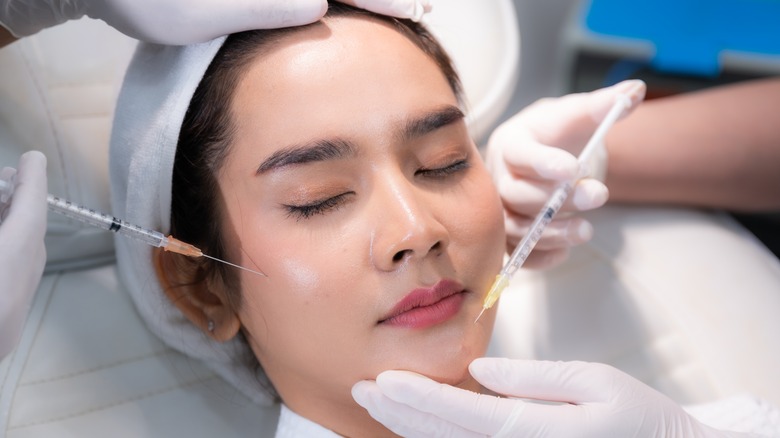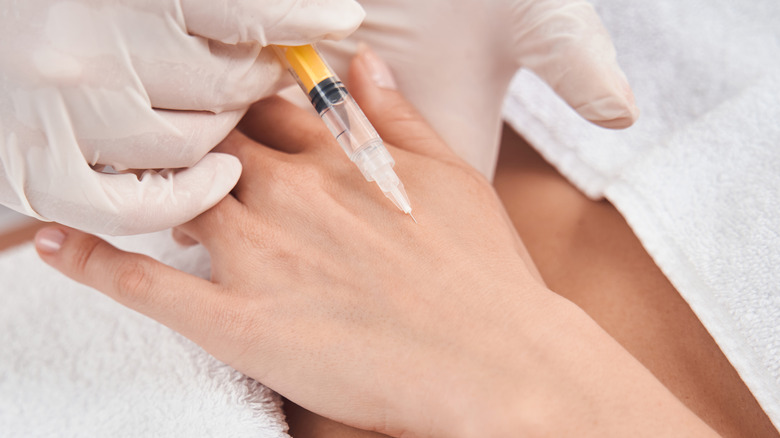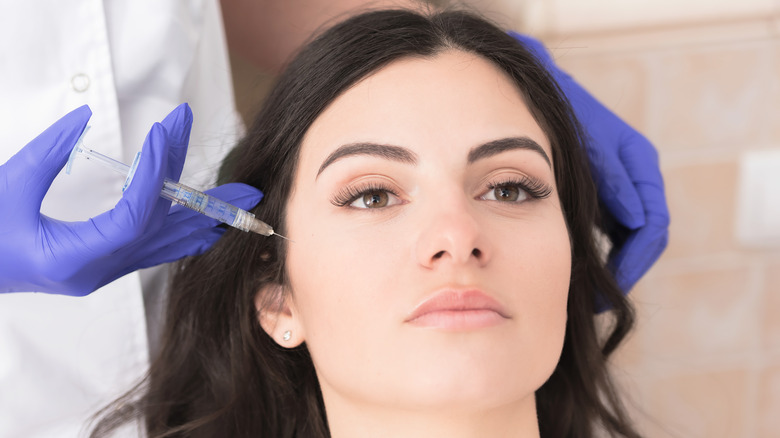Biostimulatory Fillers: What To Expect And How They Differ From Similar Procedures
Fillers have soared in popularity over the past decade, with an estimated surplus of one million people getting the plumping procedure between 2010 and 2016 (via CNN). Some of these procedures include lip filler, jaw filler, chin filler, and the use of filler to contour the face. Fillers are often used to plump and add volume to specific areas of concern, for example, if one wants to achieve the effect of having "bigger" lips or a more defined jawline.
However, there are also different types that you can get. While many of us traditionally think of filler as a tool used to plump different areas of the body, such as the lips and cheeks, it is also used to achieve other desirable effects. Meet biostimulatory fillers. While you may have never heard of them, this type of filler differs from traditional hylauronic acid fillers you are likely already familiar with. So, what can you expect from this treatment, and what makes them so different?
Biostimulatory fillers target different deep signs of aging
Biostimulatory fillers are considerably different when compared to hyaluronic acid-based fillers. While hyaluronic acid-based filler adds instant volume and plumps specific areas, biostimulatory fillers don't do that. Instead, they work by stimulating collagen, which stays in your body and produces a more volumized look over a longer time period (via AEDIT). This filler is great for targeting areas of concern such as "declining bone mass, skin sagging, and less elasticity," explains Julie E. Russak, M.D., and Board Certified Dermatologist (via Who What Where).
Doctors use biostimulatory fillers to target larger areas, such as your cheeks or hands, rather than more delicate areas, like under your eyes or lips. They also use them to volumize and shape your face, which helps clients to achieve a more youthful appearance and combat any signs of aging. In comparison, hyaluronic acid fillers are often used for smaller, more specific areas of concern, such as forehead lines, or to add volume to your lips in the form of lip fillers.
They last longer than hyaluronic acid-based filler
As well as targeting different signs of aging, biostimulatory fillers boast other unique qualities. In terms of their longevity, they typically last much longer than hyaluronic acid-based fillers. But how much longer exactly? Surprisingly, results can last anywhere between 12 to 24 months, which is a considerable amount of time compared to hyaluronic acid-based treatments that last around six to 18 months. If you decide to get biostimulatory fillers, you'll have a guaranteed extra six months to flaunt your new look versus if you got a hyaluronic-based treatment.
This long-lasting result boils down to the collagen stimulation effect mentioned earlier. As the newly stimulated collagen remains in the body, this helps to give a longer-lasting result that will stay for a long time. However, the results of hyaluronic acid filler are much more temporary because your body breaks it down over time. How fast this process happens usually depends on an individual's metabolism. The faster someone's metabolism is, the faster it usually breaks down.
You won't see instant results with biostimulatory fillers
Now that you know a little bit more about how biostimulatory fillers work, you may want to know what to expect when deciding whether to undergo the treatment. Although they are quite different from traditional hyaluronic acid-based fillers, you can still expect great results. However, unlike hyaluronic fillers that give instant results, you won't see them immediately with biostimulatory fillers. Instead, you will have to wait patiently over the course of between two to six months. Over this period of time, your body is building up collagen and elastin (via Who What Where), hence why it takes more time to see any significant changes. After a period of between two to six months, you should start to notice a clear difference within the treated area, with added volume and extra firmness to your skin.
However, thanks to these long-lasting results, you will likely only need a touch-up once per year, making it an arguably "lower maintenance" option when compared to dermal fillers. Of course, like with any treatment, you may experience some minor side effects such as "bruising, swelling, and redness" (via RealSelf). These should all subside within a few weeks following your initial treatment. If side effects persist, then it is best to contact a doctor for further recommendations.
Results will be subtle compared to hyaluronic acid-based fillers
Biostimulatory filler is best for those who want more subtle results rather than something more dramatic. The beauty of this is that the results tend to look very natural, and people probably won't be able to tell you've had any filler. Of course, this is great for those who want a more subtle, natural look than a hyaluronic filler's more dramatic results. But why do the results end up looking more natural? Once again, this comes down to how the filler stimulates cell regeneration and collagen production, allowing your body to generate incredibly natural results.
However, it is important to note that results with biostimulatory filler are not as easily reversible as they can't be dissolved. For this reason, it is best that a well-qualified board-certified dermatologist or plastic surgeon performs the procedure. This way, you're giving yourself the best chance that the procedure will be performed correctly.




